

News in 2015
|
A majority of the participants are generally happy with the FIG Working Week in Sofia, Bulgaria. 90 percent of the respondents of the post-conference survey indicated that they were overall satisfied. However, the survey also showed some areas of dissatisfaction, hereunder obsolete conference facilities; varying scientific level and not so inspiring lunches. The feedback is highly appreciated, and it will be taken seriously and will enable FIG to better plan and execute future conferences.
Shortly after this year’s FIG Working Week in Sofia, Bulgaria a post-conference survey was sent to the attendees. The objective of the post-conference survey was to determine whether the attendees valued the Working Week; whether it was worth their investment of time and resources; and whether they would participate in a FIG Conference again. Further, the survey will enable the organizers to better plan the forthcoming FIG Conferences so the efforts put into the planning meet expectations for attendees, speakers, exhibitors, and sponsors.
This evaluation is based on completed questionnaires from 30 percent of the participants. Despite the relatively low response rate, this evaluation nonetheless gives an indication of the general impression and experience with the Working Week. A mistake in the first survey that was sent out may also have affected the numbers of responses negatively.
50 percent of the respondents come from Europe and 25 percent from Africa. This correlates well with the characteristic of the attendees at the Working Week. It is interesting to note that the respondents are equally divided between academic, public and private sector. This matches the overall number of participants.
Although it would have been nice with a 100% response rate, 30% still gives a fairly good indication of the impression of the Working Week.
The background information of interest in the survey is as follows:
Where do you live?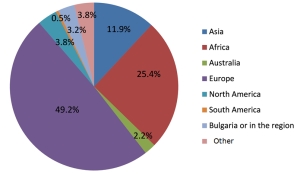 |
In which area of profession do you predominantly
work?  |
Have you attended previous FIG Working
Weeks/Congresses?  |
|
90 percent of this year’s participants – or at least the respondents in the post survey - are overall satisfied with the FIG Working Week in Sofia, Bulgaria. 50 percent found the Working Week great and fulfilled their expectations. 43 percent found that the Working Week was acceptable and had minor weaknesses, but fulfilled their expectations to a great extent. While 10 percent found the Working Week poor and did not fulfill the expectations. Some of the areas of dissatisfaction were obsolete conference facilities; varying scientific level and the uninspiring lunches.
The overall positive feedback does not prevent the organizers from thinking in new ways that can develop and improve future FIG conferences. We highly appreciate the feedback - complaints, compliments and great ideas, which we have received in this post survey. The comments will be taken seriously and will enable us to better plan and execute next year’s conference in Christchurch, New Zealand.
What is your overall assessment of the FIG Working Week?
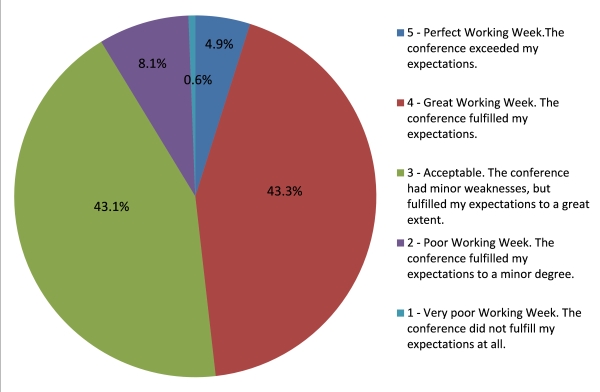
Overall, the technical programme was rated very satisfying. Many emphasized that the conference was inspiring and that the different sessions, workshop and forums were fruitful and encouraged to discussions.
PLENARY SESSIONS
During the Working Week one plenary session was organised each morning. The plenary sessions were built over the overall focus of FIG Council for the term and focused on the Surveyors’ Response to Changing the City Management, to Pro-Growth Land Management and to Global and Regional Professional and Institutional Reforms.
The plenary sessions were rated according to quality, relevance and whether the sessions were rewarding. There was general satisfaction with the plenary sessions, 70 percent of the respondents agreed or strongly agreed that the plenary sessions were relevant, rewarding and of high quality, while only 4 percent disagreed. 10 percent did not attend the plenary sessions.
How will you rate the following aspects of the technical programme?
The plenary sessions were of high quality (%)
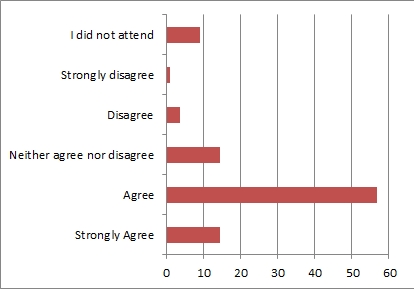
The plenary sessions were relevant (%)
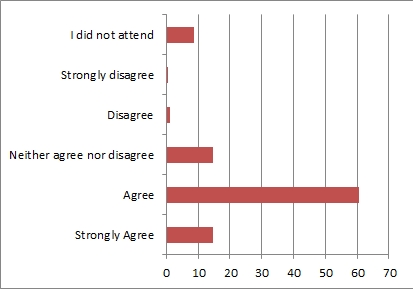
The plenary sessions were rewarding (%)

The plenary sessions are a crucial part of the conference, as they are to set the overall standard and tone and summarize the core message / revelation of the conference. Each year the FIG council, FIG office and the local organisers discuss how the overall theme can be covered from different angels (including all ten FIG commissions) and who would be suitable and notable persons, who can make an inspirational, dynamic, informative and memorable plenary speak.
In the post survey, some of the respondents commented that not all the plenaries was interesting/relevant and that the presentation skills of some of the speakers lacking.
“Plenaries need to have good speakers with interesting topics”
“Some of the plenary session speakers did not seem to be very relevant”
“…more visionary or strategic topics in plenaries”
Other respondents indicated that the plenary speakers did not cover the themes of all ten FIG commissions
“I would like to see that the plenary session should have at least one speaker on the construction sector.”
TECHNICAL SESSIONS
73 percent indicated in the post survey that the technical sessions were of high quality / scientific level, relevant and rewarding. The sessions were dynamic, productive and informative. The following parameters were tested:
How will you rate the following aspects of the technical sessions?
The scientific level of the technical sessions (%)
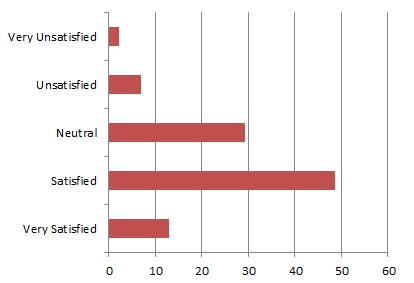
The technical sessions were of high quality (%)

The technical sessions were relevant (%)

The technical session were rewarding (%)

The programme included 320 presentations throughout the three conference days. The presenters came from 60 countries and had a background from academia, private practice and government.
“My primary complaint has to do with the quality of papers and presentations. Many of the topics, while catering to presenters of various cultures, were not properly curated (i.e. were not at a level of what you expect at an international conference), and others had very poor presentation, much to the detriment of the content therein. It would be a very good idea for FIG to provide some of the attendees with more resources with which to better present the work they have done.”
FIG strives to offer a balanced program, with presenters with diverse cultural and professional background. Each paper is given careful and deliberate consideration and the selected proposals have to fit the overall theme of the conference. On the other hand, the presenters are accepted based on their abstract, not on their ability to engage or communicate through a presentation. Some of the respondents suggest that
“…some speakers need to be educated in speaking into microphones and using PowerPoint presentations!”
On future conference websites, some general guidelines on presentation technique will be uploaded.
Further, the session chairs also play a key role in increasing the level of the technical sessions, and make the session interesting, informative and educational. The session chair has to lead the session making sure that the presenters are introduced accordingly; that the timetable is kept; and that the audience is involved through questions and discussion.
“More could be done to better schedule the event, as quite a few 5 minute presentations actually had quite a bit of interesting content, whereas other 10-15 minute presentations were all fluff. It is disappointing to see that a lot of good work took a back seat at the conference for whatever reason, as I think this detracted from the technical sessions and conference overall. Further to this point, many chairs were not rigorous enough about enforcing time limits, as more than a few poor presentations droned on for over half an hour.”
80 percent of the respondents found the sessions were effectively moderated, while 4 percent disagree. 12 percent neither agreed nor disagreed.
The comprehensive programme, with 11 parallel sessions resulted in overlapping sessions which appealed to the same participants. It is a puzzle to create the technical programme, taking all parameters into consideration.
“Some technical sessions / other sessions with similar topics were scheduled at the same time. Difficult to choose.”
We interpret it positively that it is difficult to choose which sessions to attend. One of the respondents came with the following solution
“Consider a breakout period for posters and then have special meetings during this. The Directors General Forum conflicted with several key technical sessions. By having the DG Forum during a time slot that is parallel to a poster session, this would avoid conflicts with any technical sessions.”
Another issue which was addressed in the post survey is “no-shows”; presenters who do not show up and make their presentation. The FIG Office tries on-the-spot to update and modify the conference programme, thus to avoid sessions with very few presenters. The FIG Office will also encourage the presenters to let us know if they are prevented to attend the conference so the paper can be removed from the programme.
The Working Week took place at the National Palace of Culture - the very same place as the FIG Permanent Committee Meeting in 1983, however at that time under very different conditions. The FIG conferences have grown in number of participants and presentation, thus the demands of the venue is different. The conference center opened in 1981; hence the facilities were brand new and very impressive in 1983. In 2015 many of the respondents found the session rooms not up-to-date and did not meet the modern standards for conference facilities. The conditions were inconvenient and not suitable for the purpose of presentations. The design of the rooms made it difficult to see the screen with the PowerPoints; the acoustics were not optimal; the lightning was poor and the indoor climate was thick.
“A special attention should be paid to the conference venue which was very obsolete this time. Some of the conference rooms were so badly designed that it was impossible to hear or see anything (unless you managed to get to the five seats in the first row).”
By moving the conference from destination to destination, different standards of the conference facilities will apply. This makes the bids very important, as it needs to give the decision makers an impression of the current condition of a property and surroundings. Further, before each conference representatives from FIG Council and FIG office make a site visit. A personal site inspection visit is a must to get an idea whether the conference facilities meet our requirements or how we can make it work as optimal as possible. This is however sometimes a challenge.
The technical facilities were on the other hand very impressive. The technical staff was very professional; from the guys in the Speakers Presentation Room to the staff in the session rooms. The technical equipment was not the most up-to-date, but the technical service and support was brilliant. Further, the National Palace of Culture offered free Wi-Fi, this service provided the participants with basic wireless Internet connection to check email or surf the web at no cost. More than 70 percent of the respondents were very satisfied or satisfied with the Wi-Fi onsite.
How would you rate the Internet access onsite? (%)

At this year’s FIG Working Week the organisers introduced a new feature. The traditional printed technical programme was supplemented with a new developed application for Smartphones and Tablets.
The statistic for downloads shows that 20 percent of the participants used the app. Those who downloaded the app also used the features the app had to offer; checked the technical programme, made favorite markings of sessions, speakers etc. This means that those who downloaded the app have been returning users and used it pretty effectively.
The survey shows that 59 percent were satisfied or very satisfied with the conference application. This indicates that the participants value the initiative, and we will continue to develop and promote the app.
How would you rate the Conference App? (%)

The post survey shows that participants also value the printed programme. The printed programme will be available at future FIG Conference for those who do not use the digital option or to use in addition to the electronic programme. However, with the application, the organizers have the opportunity to update the programme right up to the start of the conference, thus get the last-minute changes included.
How would you rate the Programme Book? (%)

The social events were a great success. The Bulgarian organisers had done a great job to make sure that the Working Week was memorable for all participants and also managed to showcase the best of Sofia/Bulgaria. 65-70 percent of the respondents who attended the Bulgarian Dinner/FIG Foundation Dinner and the Gala Dinner found the dinners satisfying or very satisfying, while 4-6 percent were unsatisfied. 25 percent were neither satisfied nor unsatisfied.
How will you rate the following…?
Bulgarian Dinner/FIG Dinner (%) |
Gala Dinner (%) |
The Welcome Reception took place in the National Museum of History, which is a very spectacular and large venue – a former governmental residence. Currently it stores and owns over 650,000 objects connected to the history of Bulgaria. The Welcome Reception was well attended, and the survey shows that 85 percent of the respondents were satisfied or very satisfied with the evening. Among other things, the evening gave the participants the opportunity to meet fellow participants, and the possibility to walk around in this extraordinary building and see the exhibition, and in this way learn more about the impressive 1300 year history of Bulgaria.
How will you rate the Welcome Reception? (%)

The lunches were the most criticized issue in the survey. This year the lunch consisted of a lunch box containing a sandwich, a small salad and a piece of fruit but with very limited variety from day to day. It can be difficult to satisfy everyone's tastes, which span from the Himalayas to the Andes, Scandinavia to Southeast Asia and Nigeria to New Zealand. The Lunch offering will vary from destination to destination and will be based on a local touch but with respect to international differences and preferences. Lunches therefore will reflect local traditions.
The concept with lunch boxes will be continued, as it gives the opportunity of lunch meetings; the participants can go outside and easily manage walking with their lunch. We will however design the lunch boxes to suit and certainly give a variety of items so the participants have a variety of choice.
Despite specific areas of dissatisfaction, hereunder the lunches and conference facilities, this year’s participants - or at least the respondents in the survey – are generally happy with the Working Week. The majority of the participants who completed the survey have earlier attended a FIG Conference. We are pleased that delegates keep coming back; it is the best indicator of the popularity of the FIG Conference. We interpret is positively that 95 percent indicate that they will recommend the FIG Conferences to friends and colleagues.
Would you recommend FIG Conferences to colleagues and friends?
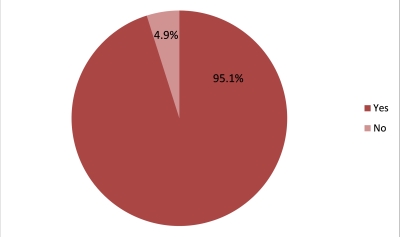
Lastly we would like to thank everyone, who participated in the post-conference survey. Thank you for your valuable contribution!
Claudia Stormoen
27 August 2015